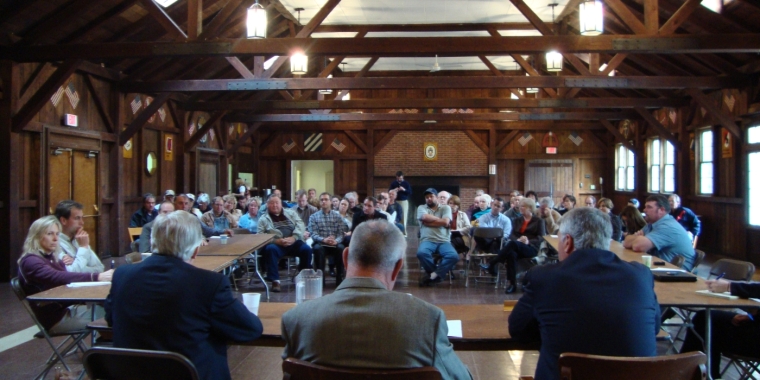Powering New York's Future: Energy Chair Aubertine Reports on Public Input from Statewide Roundtables
Darrel J. Aubertine
December 2, 2009
-
ISSUE:
- Energy
-
COMMITTEE:
- Energy and Telecommunications
Over the course of the low cost energy roundtables several themes and ideas emerged from the dialogue between Chairman Aubertine and the State’s business leaders, community groups, environmentalists, good government groups and other regional stakeholders.
Themes and ideas are listed below.
Future of Programs/Reform
· It was suggested that all 9 low-cost power programs be eliminated
· Suggestion the low-cost power economic development programs needed reform as follows: (i) should use identical criteria as the State’s other economic development programs, to ease application and compliance; (ii) the power programs should adopt similar reporting requirements to the other economic development programs; (iii) there should be a “unified” application process so that one application would submit data/applications to all the programs.
· Suggestion that reallocation of power was necessary within the program
· It was suggested that the low-cost power programs needed to have an overall strategy under which they operated, because there needs to be an overall goal for the program besides simply retaining jobs/companies
· It was suggested that the low-cost power programs should provide/coordinate a single point of entry (i.e., a “one stop shop”) to complementary economic development programs
· It was suggested that NYPA should be removed from engaging in economic development and that the low-cost power programs should be administered by the Empire State Development Corporation (ESDC)
· A business development center suggested unifying all economic development programs, including low-cost power, into one agency with a “one-stop” portal and unified administration
· It was suggested that energy savings – thus allowing a limited resource to be used more broadly – is at least as important a focus for program reform as is reform of the criteria, reporting, term, etc. of the programs; and, NYSERDA’s role should be broadened in the program(s)
· One business suggested improving publicity of the low-cost power and other economic development programs because they had never heard of them before; and, particularly if the programs reopen to admit new entrants, there must be statewide publicity so that every possible entrant will be made aware
· It was suggested that providing a monetized benefit was more valuable to many companies than low-cost power, because the recipient could use the benefit more flexibly/innovatively
· A good government group suggested, and most participants agreed all of the New York Power Authority (NYPA) low-cost power programs needed to be made more transparent and accountable
· Suggestion the State needed a unified plan to apply to all its low-cost power based economic development programs
· Some participants advocated for the Gargano Commission suggestions
· Some companies discussed cogeneration/distributed generation.
Program Criteria
· Several manufacturing companies suggested that using jobs as the sole or primary criteria did not account for companies whose investment produced more efficient production, rather than more jobs
· Several companies suggested capital investment should be a criterion of the program, citing the example of a $500 million investment in paper company’s infrastructure that might only create 80 jobs.
· Several companies said efficient use of the power should be a criterion
· Other non-business participants suggested the program(s) should be: (i) “allocation based” – i.e., awarding fixed amounts of hydropower; (ii) prioritized by which awards created the best rewards to the State; and (iii) required to use the same criteria as the Empire Zones program
· Good government groups suggested avoiding the Industrial Development Agency (IDA) model of weak criteria and portable benefits; also, the award of benefits to new entities must be fair to existing recipients and if a company does not agree to comply with new requirements (such as, e.g., energy efficiency work), it must be safely transitioned out of the program
· Another suggestion was to award some of the benefits under a “vesting” model, such as: (i) loan a business the money to make energy efficiency improvements, and for each year the company stays in the program and meets criteria, the loan would be lowered by a percentage until it reach $0 repayment at the end of a predefined period; additionally, (ii) companies could be given incentives in beginning based upon a negotiated business success outcome, but as a company exceeded its success goals it could be given more incentives to continue to grow (a “credit earning” model)
· It was suggested that any criteria for the award/retention of the low-cost power benefit should value the amount of capital a program recipient has invested into its business
· One business suggested NYPA raises the “job commitment” program benefit recipients must achieve, and that such increases are not done transparently or with sufficient process
· It was suggested that the average salary of jobs created/retained should be a criterion
· The participants suggested there should be an overall cost-benefit analysis of the low-cost power programs
· It was suggested that the award of benefits should be tied to industries/companies that attract (or are most likely to attract) investment capital and those that provide job retention
· It was suggested that the sustainability of an industry should be a criterion, and that companies should not receive a benefit of more value than the job(s) created
· A business trade association suggested creating different tiers of the low-cost power program(s) because the existing recipients cannot easily be judged based on one set of criteria (e.g., manufacturing entities are capital and not labor intensive, whereas nonprofit entities may be labor of capital intensive dependent upon their focus)
· It was suggested that NYS sourcing of raw materials/purchasing for a company should be a criteria of awarding the benefit of low-cost power
· It was suggested that regional impact of a recipient company’s job development/retention and/or capital investment and/or supply chain multiplier effects should be considered as criteria
· It was suggested that companies that work to reduce their waste stream and develop alternative energy sources while in the low-cost power program should get “preference points”
· It was suggested that every recipient company’s compliance with program criteria should be evaluated annually
· It was suggested the value of a company’s exports should be considered as a criterion
· It was suggested that the “green jobs” quotient or “high technology” quotient of a program recipient be considered as criteria
· It was suggested the number of “carbon credits” an entity produces should also be a criterion for receiving benefits
· A good government group suggested adding a criteria rewarding businesses that located into distressed census tracts
· It was suggested that the award/benefit retention criteria should balance number of jobs created/retained directly against capital investment and certain other business growth and supply-chain business multiplier criteria
· One company suggested analyzing and resolving the contradictions between the low-cost power, energy efficiency and empire zone programs (e.g., the company turned down low-cost power because they couldn’t meet the job creation criteria despite significant capital investment
Length of Programs
· Several companies suggested 10 years as the right length of time for how long the program should last.
· Suggestion that a company’s receipt of benefits should be 7-10 years because that was the “life” of a product line, which is what financing entities consider when extending credit/capital
· A business support group suggested an initial 5 year term, with an expectation of a 2 year renewal
· Others suggested that 5-7 years is the right length for how long the program should last.
· One business suggested a 10 year benefit period, but that retention in the program must be tied to energy efficiency investment and business capital investment targets
New and Existing Applicants
· Several companies and good government groups suggested the program(s) needed to be opened up to allow new applicants
· It was suggested that nonprofit low-cost power recipients were important to many localities and should remain eligible for the economic development benefit(s) of low-cost power
· It was suggested that companies should not continue to receive benefits after the program period because that would turn the program into an entitlement, rather than a temporary benefit from the State
· Some participants, but not all, suggested that non-profits should not be included in PFJ.
· It was suggested that even if a new entrant would produce more jobs at equivalent wages to an existing low-cost power recipient, the benefit should not be switched to the new entrant
· It was suggested that the minimum award of kilowatts an entity could apply for should be lowered to create more flexibility
Energy Efficiency
· All companies, good government groups and environmental groups in Long Island agreed that the low-cost power programs must require energy efficiency measures and/or efficient energy usage
· LIPA suggested examining and applying its energy efficiency model(s), along with subsidy of energy use audits and phased application of efficiency measures over time
· The environmental groups asked if lowering energy costs was contrary to promoting energy efficiency (and the Governor’s energy policies); a discussion arose whether the hydropower should be completely monetized and the proceeds used to create other incentives for the program recipients.
· The environmental groups suggested low-cost power distorted market signals, and that all low-cost power should be monetized an invested into other types of incentives for economic development recipients
· Several participants suggested awarding low-cost power while a company is undertaking energy efficiency improvements, then tapering off low-cost power in concert with a company’s decrease in usage because of greater efficiency
Rural & Domestic Power
· Suggested Rural & Domestic power (R&D power) should be redistributed for use by businesses
· All attendees agreed that flexibility of reallocation was desirable, the reallocation of R&D power should be considered
Energy Costs
· It was suggested that the State should consider acting to drive down the cost of energy delivery to program recipients
· It was suggested that predictability of the price of the commodity – energy – was even more important than achieving the lowest possible energy price
· It was suggested that New York set the price of low-cost power at $0.04-$0.05 per kilowatt hour to be competitive against the states with the lowest energy costs
· It was suggested that if a fixed-price is set for the low-cost power benefit, it must drift downward if commodity price of energy lowers, because a previous Power for Jobs (PFJ) period allowed the PFJ energy price to exceed market price and recipients lost significant sums of money to stay in the program
Hydropower/Green Power
· Local business support groups in Niagara Falls/Buffalo region suggested “green power” was a significant draw to Western NY and NY in general, and that the possibility of “green-to-green” manufacture of green products via green power was a particularly strong additional draw
· Many participants said providing low-cost power at a discount from market rate was not sufficient, and that there must be fixed rate hydropower allocations made
· A municipal distribution agency (MDA) suggested more low-cost hydropower needed to be allocated to such users, and they needed reallocation flexibility within their program period(s)
· It was suggested that the low-cost power programs should create a new category for companies creating “green jobs” and “green careers”, and that such companies should get benefits
· It was suggested that the hydropower allocation should be targeted to those companies who wish to manufacture green products in the state.
· It was suggested that monetization of the hydropower should be strongly avoided, however it was pointed out that a “cash subsidy” was more flexible than a fixed allocation of hydropower and could be spread more broadly to more companies
· One company suggested they needed a fixed amount of dedicated hydropower at a fixed price.
· Another non-business entity suggested that providing hydropower to municipal energy entities and municipal & rural cooperatives did not incentivize them to focus upon energy efficiency
· Nat’l Grid suggested “green cogeneration” could be a useful direction
Business Incubators
· Academic participants suggested low-cost power should be made available to business incubators as part of the “incubator benefits” packages to incentivize the creation and growth of new businesses
· Another suggestion was that incubator companies should receive “wraparound” help beginning from incubator phase and continuing until they graduate from an incubator; reflecting long-term plans to create, grow and retain new businesses (the theory is that if a company is given support until it enters a growth phase, it will create local lock-in)
· There was a suggestion that each county might put forward a business incubator to receive low-cost power
“Proceeds”/”Monetization”
· It was suggested the State should consider reinvesting some of the “proceeds” of monetization into creating more sources of low-cost power
· Suggestion that unallocated power should be monetized (i.e., sold on the open market) and the proceeds used for further benefits to existing program benefit recipients
· There was some discussion on whether any of the proceeds from monetized power should be used to upgrade transmission lines
Share this Article or Press Release
Newsroom
Go to Newsroom
Aubertine, Burling, Koon Host Agriculture Roundtable
October 21, 2009

